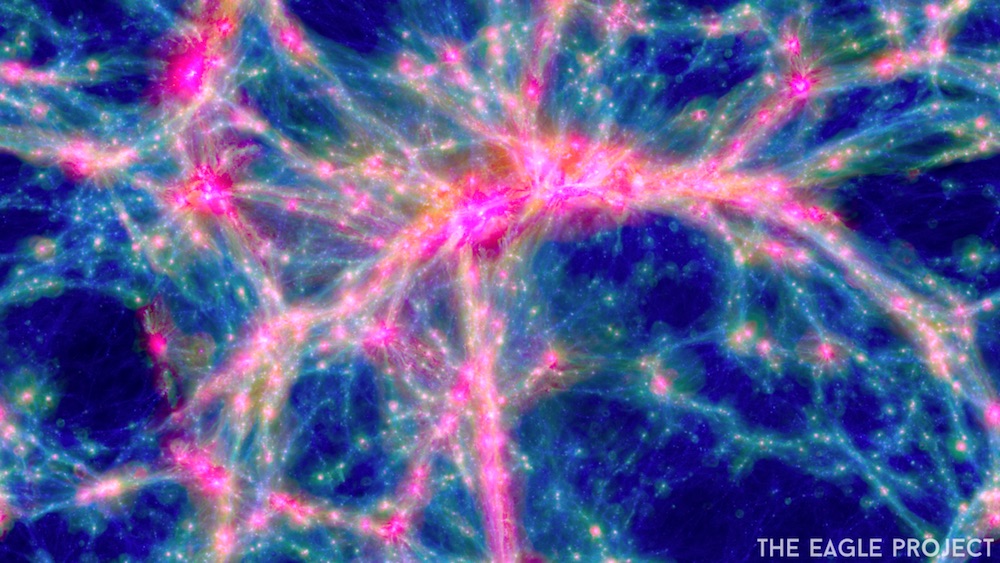Neutrinos Entangled in the Cosmic Web May Change the Structure of the Universe

Like flies trapped in a silken spider web, ghostly particles known as neutrinos are entangled in a cosmic web of galaxies.
They have almost no mass. They pass like subatomic apparitions through other matter, barely interacting with it.
And yet, these mysterious particles have fundamentally altered the course of the universe, new research reveals.
Looking at more than 1 million galaxies, scientists determined how neutrinos' gravity subtly affected the locations where galaxies first coalesced after the Big Bang. The results provide a glimpse of what scientists think is the earliest observable moment after the Big Bang. [Big Bang to Civilization: 10 Amazing Origin Events]
The new result "adds to the strength of our conviction that we really understand how the universe evolved from about a second after the Big Bang onward," said study co-author Dan Green, a cosmologist at the University of California San Diego.
From hot mess to ghostly web
Shortly after the Big Bang, the universe was a soupy mess of neutrinos, electrons, neutrons, protons and photons. One second in, neutrinos — the lightest and least interacting of the particles — were the first to separate from the rest of the matter, and zoomed out into the expanding space of the universe at nearly the speed of light. Scientists call this distribution of first neutrinos the cosmic neutrino background.
Fast forward about 380,000 years, and the universe cooled enough that protons and electrons congealed into atoms and released the universe's first light — the cosmic microwave background. The rapid outward expansion of particles slowed as atoms, tugged by gravity, began to clump together. Overtime, galaxies seeded at the larger, highest density clumps, eventually forming the web of galaxies visible across the universe today.
Get the Space.com Newsletter
Breaking space news, the latest updates on rocket launches, skywatching events and more!
The cosmic microwave background can provide a glimpse of the initial distribution of matter in the fairly early universe. But the protons and electrons weren't the only things affecting the structure of the universe — neutrinos also played a role.
Because the neutrinos were first to leave the soup of particles and have hardly interacted with anything since, they wound up in slightly different locations than the clumps of atoms. This, scientists hypothesized, left a slight but visible effect on the structure of the cosmic web. By studying 1.2 million galaxies, the scientists confirmed that neutrinos' gravity slightly altered the structure of the web. Their results were published Feb. 25 in the journal Nature Physics. [8 Ways You Can See Einstein's Theory of Relativity in Real Life]
Previously, scientists had only seen indirect hints of the neutrinos' effects within the cosmic microwave background. "This is the first piece of evidence from the distribution of matter and galaxies," Green told Live Science
While the cosmic microwave background provides a snapshot of the universe after a few hundred thousand years, the cosmic neutrino background can re-create the first thousand or so seconds, offering the earliest look at the observable universe.
Today, neutrinos continue to elude scientists who study them, as they interact so weakly with atoms, dark matter and even other neutrinos. The new results, which showcase the feeble interaction between neutrinos and matter, may also help scientists better understand these elusive particles on smaller scales here on Earth, Green told Live Science.
"There is a close link between the large-scale and small-scale studies of neutrinos," said Bill Louis, a physicist at the Los Alamos National Laboratory who was not involved in the new research. "Combining large-scale and small-scale studies will help us understand more about both neutrinos and cosmology."
The discovery may even be able to help determine if there is another type of neutrino in addition to the three already known, Louis told Live Science.
- The Biggest Unsolved Mysteries in Physics
- The 11 Biggest Unanswered Questions About Dark Matter
- The Mysterious Physics of 7 Everyday Things
Originally published on Live Science.
Join our Space Forums to keep talking space on the latest missions, night sky and more! And if you have a news tip, correction or comment, let us know at: community@space.com.

Mara Johnson-Groh is a contributing writer for Live Science. She writes about everything under the sun, and even things beyond it, for a variety of publications including Discover, Science News, Scientific American, Eos and more, and is also a science writer for NASA. Mara has a bachelor's degree in physics and Scandinavian studies from Gustavus Adolphus College in Minnesota and a master's degree in astronomy from the University of Victoria in Canada.










